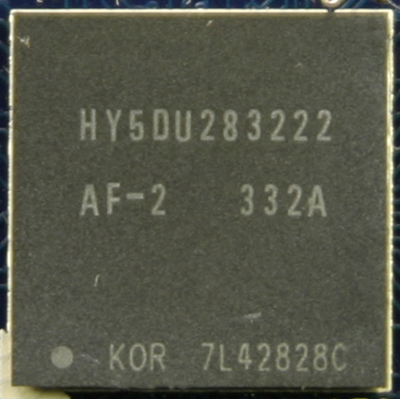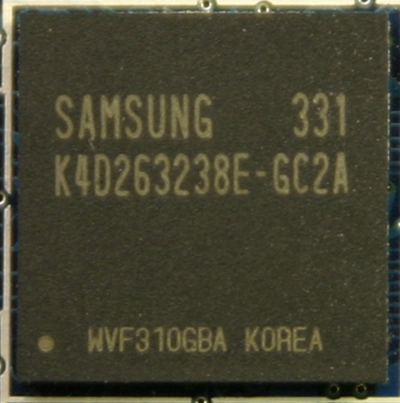Memory Modules
Before DX9 cards came along, memory speed and bandwidth were all important. There were plenty of instances in which GPUs were starved for action because they weren't able to get data fast enough. Now, though, raw computing power is presenting itself as the main driving force behind high quality graphics. The reason for this is that some cool effects, which used to be done with a memory trick, can now be done programmatically with pixel and vertex shaders. This doesn't mean that having fast memory is unimportant (we still need to move a high volume of data), and we are going to try to get as much data flowing as possible for this review.The two memory makers that we are going to see coming to the plate in this roundup are Samsung and Hynix. On both ATI's and NVIDIA's top end cards, we are seeing Hynix GDDR-II modules on board, while the mid-range products are outfitted with the Samsung parts.

Hynix 2ns Ram Module
The high-end Hynix HY5DU283222 and Hynix HY5DU573222 are used on NVIDIA 59xx and Radeon 98xx cards, respectively. NVIDIA requires 2ns RAM for its 5950 cards to hit a 950 MHz data rate, while ATI only needs the 2.5ns modules, as it doesn't need more than an 800MHz data rate. The NVIDIA GeForce FX 5900 that we tested sports 2.8ns Hynix RAM rather than the 2ns of the 5950s.

Samsung 2.8ns Ram Module
RAM for the Radeon 9600XT tops out at 700MHz effective rate speeds, which is more than enough room to hit the reference specification of a 600MHz data rate. The Samsung RAM that NVIDIA employs is a bit faster at 2.2ns, and we have seen some cases where this RAM ran stable beyond the 900MHz data rate, which should have been its limit.
The modules themselves have a great deal to do with how fast the memory on a graphics card can be run, but beyond the simple specs of the memory itself, performance is affected greatly by board layout, latency settings, and cooling. All of these aspects are controlled by the OEM, and all of them have a large impact on how well memory on a card will overclock.
The first thing that we had hoped for when we saw that Crucial had entered the graphics card market was that they would equip their cards with their own RAM. Unfortunately, that's not the case, as all the cards that we've seen from them follow suit with the other cards in their category.
Since we aren't seeing any variation on what RAM OEMs are pairing GPUs, the variances in RAM speed among similar cards will be due to the aspects that we mentioned before, as well as a little luck of the draw (overclocking isn't an exact science, and every single part is unique even if its from the same batch of chips).










44 Comments
View All Comments
qquizz - Thursday, February 5, 2004 - link
They should have included the 9700PRO in the benchmarks IMOdgrady76 - Thursday, February 5, 2004 - link
Great article. Almost like old-school AT, except better in many ways. Mr. Wilson, your thoroughness is appreciated and made for a great read.TheSnowman - Thursday, February 5, 2004 - link
if if you look back you will note that i did ask if you knew why the discrepancy existed. if i didn't know myself, i would have simply asked why and not directed my question at your knowledge of the situation. while i cannot argue against your comment that the information is available elsewhere, i doubt that you can argue that the omission of it in your review undoubtably serve to mislead the portion of the community who is not aware that you are comparing underclocked and undervolted cards to overclocked ones. as for linking to the original technology overviews or creating a page or two on the feature sets, that doesn't seem like a good idea when a single sentence explaining the situation would be much more effective in avoiding any possible confusion.DerekWilson - Wednesday, February 4, 2004 - link
Why didn't you ask that question in the first place snowman ;-)The info was left out because we didn't feek it was relevant (the operation of reference nvidia and ati cards has been well documented on this site and on others).
If you would prefer, in future roundups we can point to our articles introducing which ever GPUs we are including. If that's not enough, we can have a page or two dedicated to going over all the features the various reference cards have.
TheSnowman - Wednesday, February 4, 2004 - link
ya actually i knew that nvidia underclocks and undervolts their cards in 2d mode, i was just curious id Derek did. it struck me as rather odd that he would go though the trouble of presenting core temps while leaveing out such a vital factor in understanding the results.TrogdorJW - Wednesday, February 4, 2004 - link
Snowman (and Derek), remember that the FX5900 cards (all of them?) have 2D and 3D speeds. This has been the case since the FX 5800. Basically, they usually run at 300 MHz core and memory (DDR = 600 MHz) and when a 3D application loads, they bump up to the higher speed. It was done initially so that they could run the "leaf blower" 5800 fan at lower RPMs when you didn't need the extra power.This is okay, I guess, but it might be an issue if you were to run games for 48 hours straight or something. Technically, I think the one speed option by ATI is better for peace of mind - if it can always run at that speed, you don't need to worry as much about instability after prolonged gaming sessions.
From the benchmarks here, I have to agree that the FX5900 SE cards seem to be the best choice right now. Relatively close to the 5900 ultra and 5950 ultra, at almost half the cost! I think more of these cards should have been included instead of the 5700 Ultras. Who would spend $175+ on a 5700 Ultra when the 5900 SE/XT/regular costs about the same ($185+) and beats it pretty soundly in every benchmark? There are also some 5900 cards that list 850 MHz as the RAM speed (the eVGA lists 700) - they might cost $30 to $50 more, but maybe they use the 2.2ns or 2.0ns RAM? They could potentiall be as fast as the Ultra cards and cost $100 less!
skiboysteve - Wednesday, February 4, 2004 - link
also the vcore of the nvidia chips is at 1.2v in 2d mode and 1.6v in 3d mode.par - Wednesday, February 4, 2004 - link
Noise and heat are a huge concern for me, so I'll probably put the 9600xt Ultimate in my sff, BUT when doom3 and some of the heavier games drop are the 4 pipes opposed to 8 gonna hurt me enough to buy a new card?AnonymouseUser - Wednesday, February 4, 2004 - link
The EVGA 5900se is missing from the Temp graphs.DerekWilson - Wednesday, February 4, 2004 - link
If you go back and look at the older scores for Unreal Tournament and Halo you'll see that (with the exception of 4xAA/8xAF in UT) ATI's high end cards haven't really done better in those two games:UT: http://anandtech.com/video/showdoc.html?i=1896&...
Halo: http://anandtech.com/video/showdoc.html?i=1896&...
If we had turned on AA/AF we would have seen ATI do better in UT.
Many people crucified the NVIDIA cards with Tomb Raider, Aquamark3, ShaderMark and Tron benchmarks. The problem is that there are popular games out there that NVIDIA cards perform better in, and that info got lost in the shuffle.
When it comes down to it, ATI's 9800XT is the best card out there if you aren't going to overclock. The 9600XT and the 5700U are just about the same in terms of goodness, and if you want a card in that price range, I'd recommend a cheap 5900 based card instead.
TheSnowman:
There are some issues with that. Since ATI and NVIDIA don't measure temp the same way, and we haven't been able to come up with a really solid way of standardizing temperature measurements between the two, we have to rely on what the driver says. We are looking for better methods of measuring the temperature of each card.
That being said, I can venture a guess on why nvidia cards idle lower. Powerstrip offers me settings for 2D and 3D operation with NVIDIA cards, but I only get one setting to play with from ATI. The standard 2D clock speed for NVIDIA GPUs is anywhere from 1 to 2 hundred MHz lower than their 3D clock speed (generally 2D for the 5950 is 300MHz core). The memory clocks were locked between 2D and 3D operation and couldn't be set seperately.